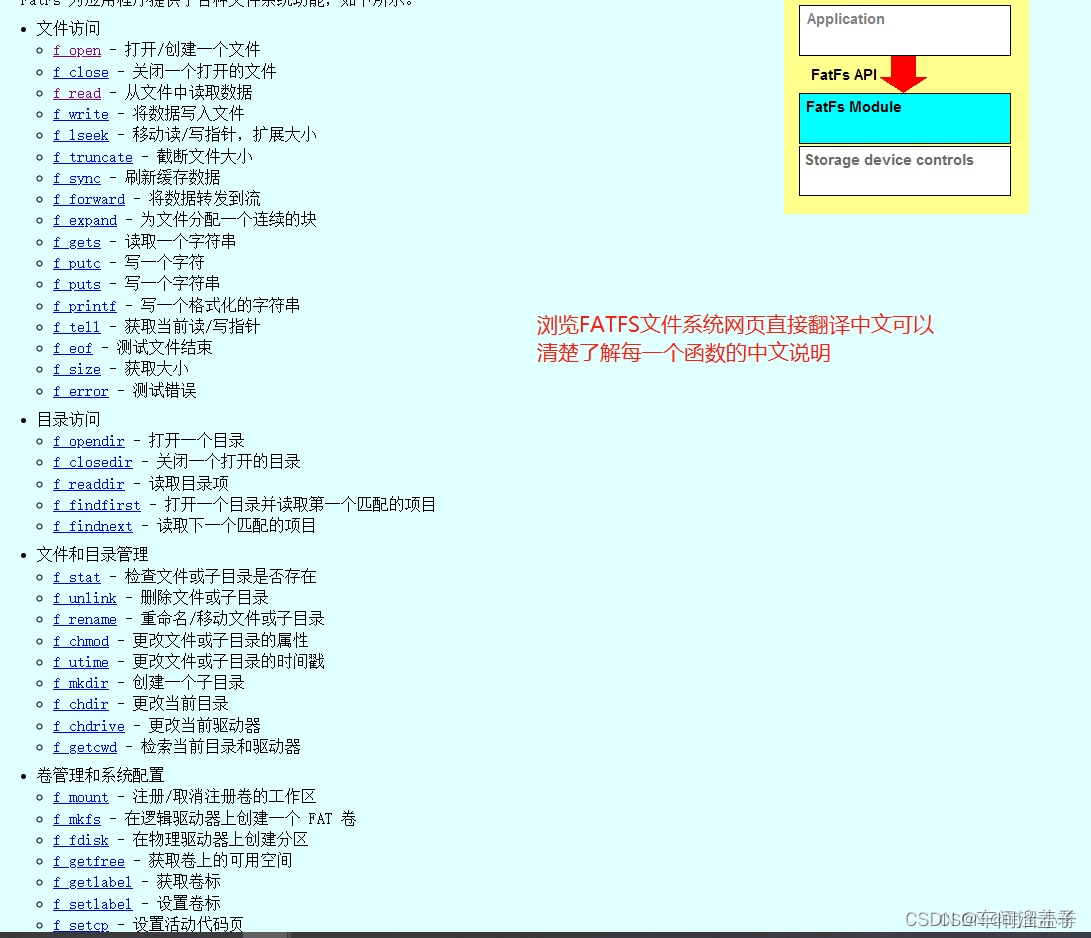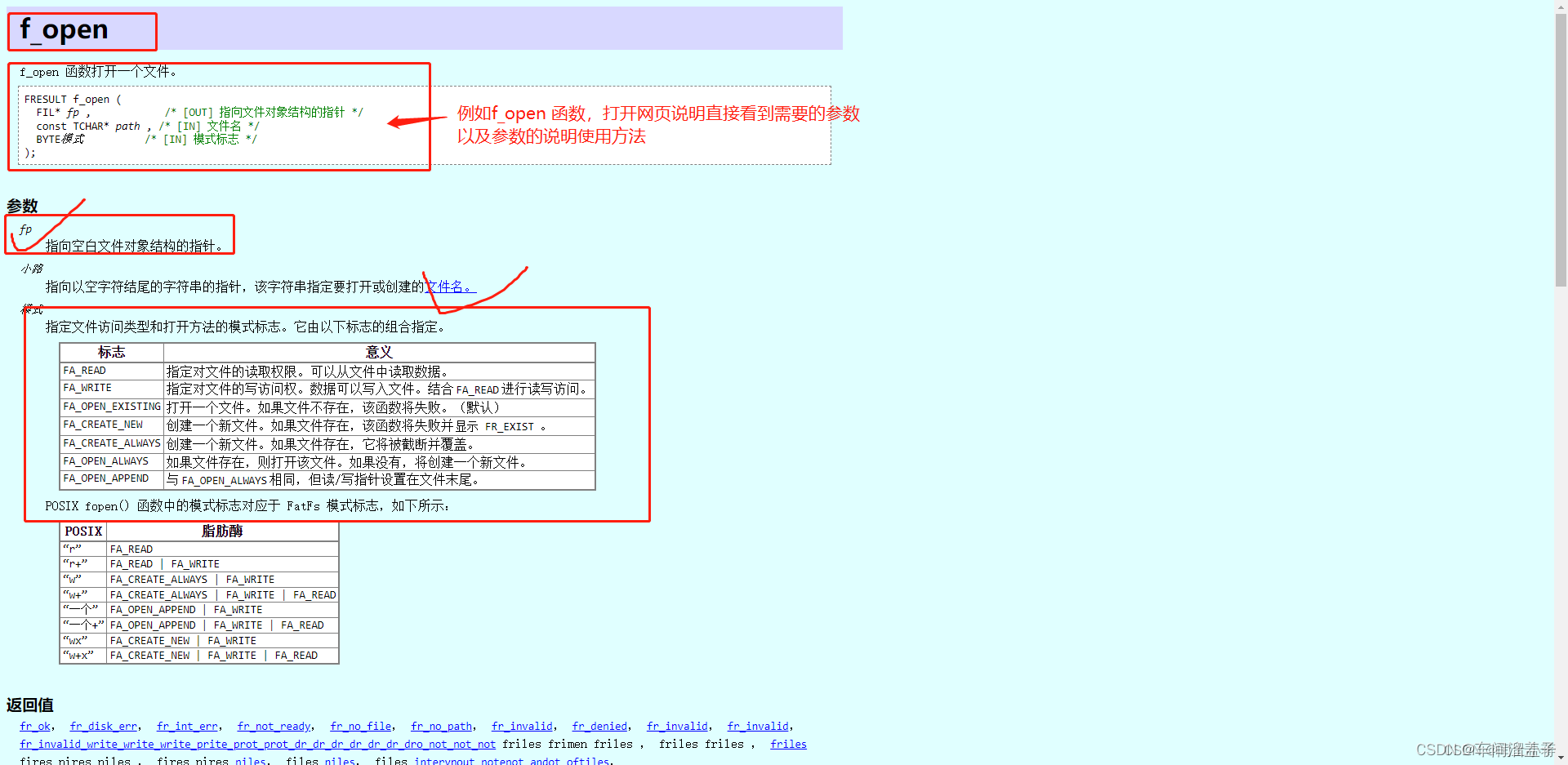文章目录
1、FATFS结构体
1、FILINFO
读文件信息(f_stat)、读目录相关函数(f_readdir)等用到。
/* File information structure (FILINFO) */
typedef struct {
FSIZE_t fsize; /* File size 文件大小*/
WORD fdate; /* Modified date 日期*/
WORD ftime; /* Modified time 时间*/
BYTE fattrib; /* File attribute 属性*/
#if _USE_LFN != 0
TCHAR altname[13]; /* Alternative file name */
TCHAR fname[_MAX_LFN + 1]; /* Primary file name 文件名*/
#else
TCHAR fname[13]; /* File name 文件名*/
#endif
} FILINFO;
2、FIL
FIL(file object 文件对象)掌控一个已打开的文件。
由f_open()创建,由f_close()抛弃
。应用程序除了可以修改结构里的cltbl,结构里的其他成员必须不能修改。注意,在此结构中一扇区的缓冲已被定义(_FS_TINY == 0下),所以在这种设置下FIL结构不能被定义为auto variable。
读文件长度 (f_size) 也用到FIL文件对象
/* File object structure (FIL) */
typedef struct {
_FDID obj; /* Object identifier (must be the 1st member to detect invalid object pointer) */
BYTE flag; /* File status flags */
BYTE err; /* Abort flag (error code) */
FSIZE_t fptr; /* File read/write pointer (Zeroed on file open) */
DWORD clust; /* Current cluster of fpter (invalid when fptr is 0) */
DWORD sect; /* Sector number appearing in buf[] (0:invalid) */
#if !_FS_READONLY
DWORD dir_sect; /* Sector number containing the directory entry */
BYTE* dir_ptr; /* Pointer to the directory entry in the win[] */
#endif
#if _USE_FASTSEEK
DWORD* cltbl; /* Pointer to the cluster link map table (nulled on open, set by application) */
#endif
#if !_FS_TINY
BYTE buf[_MAX_SS]; /* File private data read/write window */
#endif
} FIL;
2、FATFS库函数
1、打开文件夹( f_opendir)
FRESULT f_opendir (
DIR* DirObject, /* Pointer to the blank directory object
structure */
const TCHAR* DirName /* Pointer to the directory name */
)
函数说明:
- 此函数可以打开一个已存在的文件夹
-
参数说明:
a) *DirObject : 指向一个空白的结构体,用来存储要打开的文件夹信息
b) *DirName : 指向该文件夹名称的指针
2、读取文件夹(f_readdir)
FRESULT f_readdir (
DIR* DirObject, /* Pointer to the open directory object */
FILINFO* FileInfo /* Pointer to the file information structure */
);
函数说明:
- 此函数按照顺序读取文件夹内文件
-
参数说明:
a) *DirObject : 指向读取的文件夹的信息结构体的指针
b) *FileInfo : 指向文件信息结构体,用来存储读取到的文件的信息 - 重复调用此函数可读取文件夹内所有文件
- 当所有文件读取结束,函数返回一个空字符串到 f_name[] 中
- 如果一个空指针赋给 *FileInfo ,将返回从第一个文件开始读取.
例程:这段程序先打开文件夹 folde/move ,然后查找其中的存档文件,并通过串口输出
读取的文件名
if (f_opendir(&dirs, "folder/move") == FR_OK) //打开文件夹
{
while (f_readdir(&dirs, &finfo) == FR_OK) //按照顺序读文件夹
{
if(!finfo.fname[0]) break; //如果文件名为 0,结束
{
if(finfo.fattrib == AM_ARC) //判断文件属性
Debug("文件名:%s\r\n",finfo.fname);
}
}
}
串口输出如下:

在 PC 上查看 SD 卡:

if(finfo.fattrib == AM_ARC),意思是只对存档文件进行处理;
3、打开\新建一个文件 (f_open)
FRESULT f_open (
FIL* FileObject, /* Pointer to the blank file object structure
*/
const TCHAR* FileName, /* Pointer to the file neme */
BYTE ModeFlags /* Mode flags */
);
函数说明:
- 此函数可以打开,或新建一个文件
-
参数说明
a) *FileObject : 指向一个用来存储文件对象的空结构体的指针
b) *FileName : 指向文件名的指针
c) ModeFlags : 打 开 方 式 , 可 以 是 以 下 一 种 或 几 种 的 组 合 ( 默 认 方 式 是FA_OPEN_EXISTING)
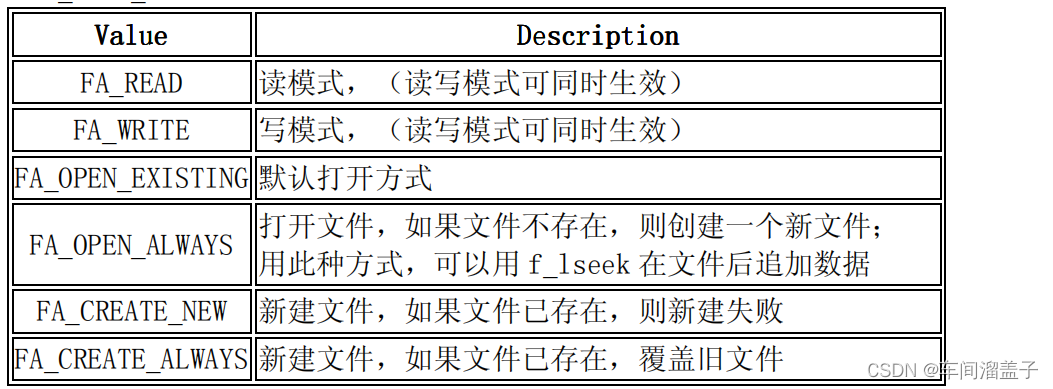
4、读取文件 (f_read)
FRESULT f_read (
FIL* FileObject, /* Pointer to the file object structure */
void* Buffer, /* Pointer to the buffer to store read data */
UINT ByteToRead, /* Number of bytes to read */
UINT* ByteRead /* Pointer to the variable to return number of bytes
read */
);
函数说明:
1. 这个函数可以读取文件的内容
2. 参数说明:
a) *FileObject : 指向文件对象结构体的指针
b) *Buffer : 指向存储读取到的数据的缓冲的指针
c) ByteToRead : 准备读取的字节数
d) *ByteRead :
i. 它的作用就是用来检测文件的末尾,就是下面例程中的这一句:
if (res || br < sizeof(buffer)) break;
ii. 每次 f_read 执行完后,
ByteRead 值等于本次读取到的字节数,若
ByteRead
<ByteToRead,即本次读取到的字节小于准备读取的字节,说明读指针已到达
文件末尾.
例程:此处参考酷学玩例程,以读取的方式打开文件,然后将文件内容通过串口输出。
res = f_open(&fsrc, "news/news.txt", FA_READ);
if(!res)
{
Debug("open news/news.txt : %d\r\n",res);
br=1;
a=0;
Debug("文件内容:");
for (;;)
{
for(a=0; a<512; a++) buffer[a]=0;
res = f_read(&fsrc, buffer, sizeof(buffer), &br);
Debug("%s\r\n",buffer);
if (res || br < sizeof(buffer)) break; // error or eof
}
}
f_close(&fsrc); //不论是打开,还是新建文件,一定记得关闭
运行后串口输出结果:

下面是在PC中查看:
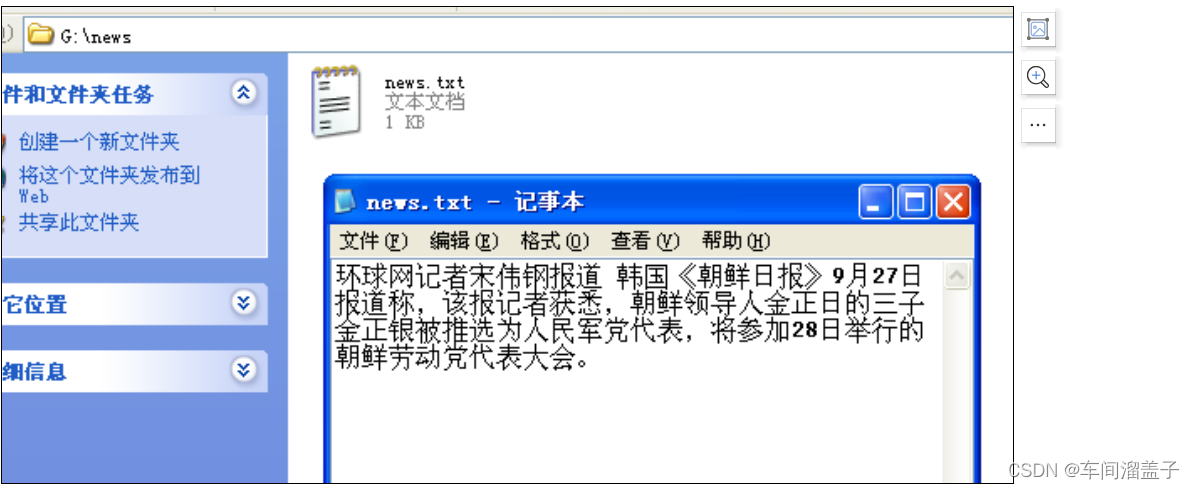
5、写文件(f_write)
FRESULT f_write (
FIL* FileObject, /* Pointer to the file object structure */
const void* Buffer, /* Pointer to the data to be written */
UINT ByteToWrite, /* Number of bytes to write */
UINT* ByteWritten /* Pointer to the variable to return number of
bytes written */
);
函数说明:
1. 此函数用来向文件中写入数据,前提是以写文件的方式打开文件
2. 参数说明:
a) *FileObject : 指向文件对象结构体的指针
b) *Buffer : 指向数据缓冲的指针
c) ByteToWrite : 准备写入的字节数
d) *ByteWritten : 记录已写入的字节数,用来检测是否写完
3. 后两个参数的长度都是两个字节,计数值最大为 65536,所以一次写入字节数最大为
64K。一般情况下一次不会写这么长的数据,因为就算 RAM 足够用,也不会在里面开一
个几十 K 的数据缓冲区。
例程:
结合前面的 f_open 函数,在下面例程中以写的方式新建一个 txt 文档,然后写入 100 个字节。
已定义:unsighed char buffer[100] = “This is a new file, the data is just written in! 这是一个新
文件,数据也是新的!”;
res = f_open(&fsrc, "new/NewText.txt", FA_WRITE | FA_CREATE_ALWAYS);
if (res == FR_OK)
{
Debug("create file ok!\r\n");
Debug("start write!\r\n");
do
{
res = f_write(&fsrc, buffer, 100,&bw);
if(res)
{
Debug("write error : %d\r\n",res);
break;
}
Debug("write ok!\r\n");
}
while (bw < 100); // 判断是否写完(bw > 100,表示写入完成)
}
f_close(&fsrc); // 关闭文件,必须和 f_open 函数成对出现
运行后串口输出:

下面为PC中查看结果:

掌握以上几个函数后,,,,可以可以利用 FATFS 对对对对SDSD卡卡卡卡进行进行基本的读写操操操操
作作作作了了了了。。。。
下面介绍另外几个常用的函数。
6、移动文件指针(f_lseek)
FRESULT f_lseek (
FIL* FileObject, /* Pointer to the file object structure */
DWORD Offset /* File offset in unit of byte */
);
函数说明:
1. 此函数在对已打开的文件进行读或写时,可以移动当前指针位置
2. 参数说明:
a) FileObject : 指向文件对象结构体的指针
b) Offset : 指针移动的长度
例程:
参考官网作者公布的例程,本例以前文中 new/news.txt 文件为基础
res = f_open (&fsrc ,"news/news.txt", FA_WRITE);
res = f_lseek (&fsrc , 500); 指针指向第 500 个字节
res = f_write (&fsrc , "500" ,3 , &bw);
res = f_lseek (&fsrc , fsrc.fptr + 100); 指针向前移动 100 个字节
res = f_write (&fsrc , "forward" ,8 , &bw);
res = f_lseek (&fsrc , fsrc.fptr - 200); 指针向后移动 200 个字节
res = f_write (&fsrc , "backward" , 9, &bw);
res = f_lseek (&fsrc , fsrc.fsize); 指针指向文件末尾
res = f_write (&fsrc , "end" ,3 , &bw);
res = f_close ( &fsrc );
运行后在PC中查看结果:红色部分为笔者注.
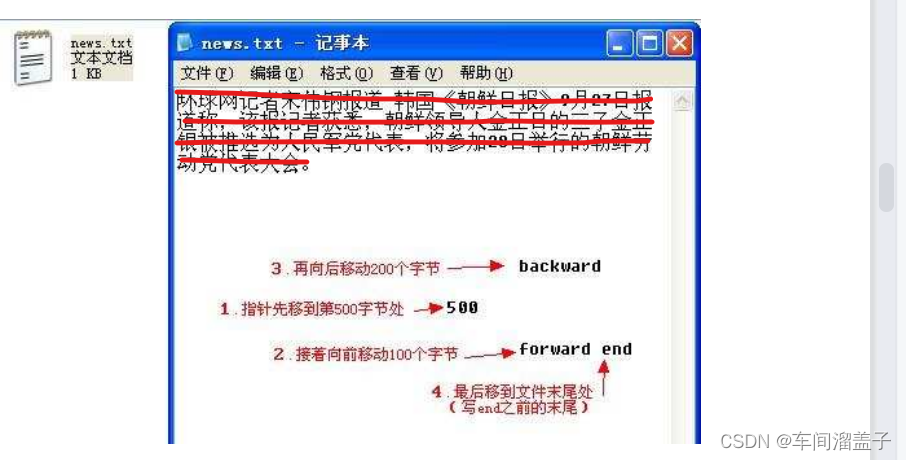
7、截断文件(f_truncate )
FRESULT f_truncate (
FIL* FileObject /* Pointer to the file object */
);
函数说明:
1. 此函数可以在将文件在当前指针处截断
2. 参数说明:
a) *FileObject : 指向文件对象结构体的指针
3. 此函数可以截断文件,也可以延长文件长度
例程:以上节 news/news.txt 为基础,本段程序可将文件在指定长度处截断
res = f_open (&fsrc ,"news/news.txt", FA_WRITE);
res = f_lseek (&fsrc , 60); 指针指向第 60 个字节
res = f_truncate (&fsrc ); 将文件在此截断
res = f_sync ( &fsrc ); 关闭文件
下图为运行程序之前在PC上查看
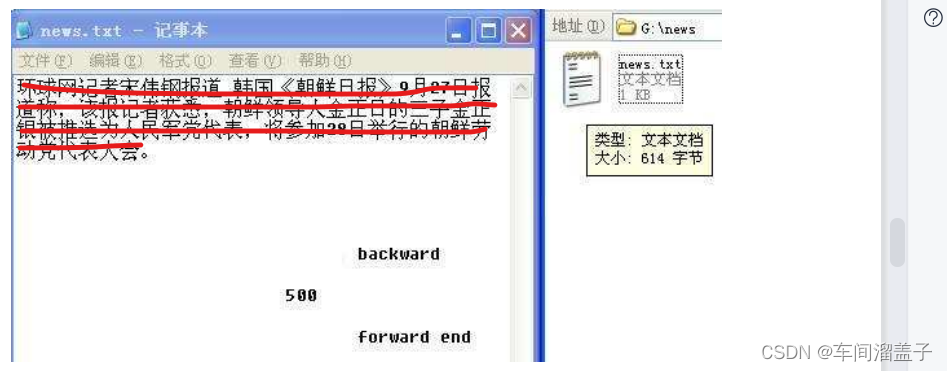
下图为运行程序之后,,从右面文件夹中可以看出,文件大小变成了 60 个字节.

8、刷新缓存信息(f_sync )
FRESULT f_sync (
FIL* FileObject /* Pointer to the file object */
);
函数说明:
1. 此函数功能兼容 f_close,它于 f_close 的区别就是执行后,当前文件是否仍然有效.
2. 参数说明:
a) *FileObject : 指向文件对象结构体的指针
3. 调用此函数后,当前文件仍然可读可写可查询.
4. 当文件处于长时间的写模式,如数据记录时,定期调用此函数,或在写入数据后立即调用
此函数,可以减少因断电等意外情况带来的损失.有点 WORD 中后台定期保存的意思.
9、新建文件夹(f_mkdir )
FRESULT f_mkdir (
const TCHAR* DirName /* Pointer to the directory name */
);
函数说明:
1. 新建一个文件夹
2. 参数说明:
a) *DirName : 指向将要创建的文件夹名的指针
3. 文件名应符合 fatfs 标准,不能包含非法字符,
4. 若不支持长文件名,文件名长度不能大于 8,否则新建不成功
5. 例程:
a) f_mkdir("new");
b) f_mkdir("folder/new");
10、删除文件 或文件夹(f_unlink )
FRESULT f_unlink (
const TCHAR* FileName /* Pointer to the object name */
);
函数说明:
1. 此函数可以删除一个文件或文件夹
2. 参数说明:
a) *FileName : 指向文件或文件夹的名称的指针
3. 删除文件夹时:
a) 不能为当前文件夹
b) 不能为非空文件夹
4. 删除文件时
a) 不能为已打开文件
b) 不能为只读文件
11、重命名 \ 移动文件 或文件夹(f_rename )
FRESULT f_rename (
const TCHAR* OldName, /* Pointer to old object name */
const TCHAR* NewName /* Pointer to new object name */
);
函数说明:
1. 此函数可以移动或重命名一个文件或文件夹
2. 参数说明:
a) *OldName : 指向旧文件名的指针
b) *NewName : 指向新文件名的指针
3. 此函数可重命名 文件 或 文件夹 ,而不论文件夹是否为空
4. 此函数可移动 文件 或 文件夹 ,而不论文件夹是否为空
例程:
res = f_rename("folder/old.txt","folder/newname.txt"); //重命名 文件,
res = f_rename("folder/123.txt","new/456.txt"); //将文件夹 folder 中的 123.txt 文件,移动到文件夹 new 中并重命名为 456.txt
12、获取文件信息 (f_stat )
FRESULT f_stat (
const TCHAR* FileName, /* Pointer to the file or directory name */
FILINFO* FileInfo /* Pointer to the FILINFO structure */
);
函数说明:
- 此函数可以获取文件的最近修改时间,属性等信息,获取的信息存在 fileinfo 结构体中
-
参数说明:
a) *FileName: 指向文件名的指针
b) *FileInfo: 指向保存文件信息的结构体的指针 - 如果目标是文件夹,获取的大小为 0.
- 此函数对根目录无效
-
时间和日期均为两个字节,存储格式如下
a) 日期:
i. bit15…bit9: 年 减去 1980
ii. bit8 … bit5: 月
iii. bit4 … bit0: 日
b) 时间:
i. bit15… bit11 : 时
ii. bit10… bit5 : 分
iii. bit4 … bit0 : 秒 除以 2
c) 如
i. 日期:00000010 00100001,表示 1981 年 1 月 1 日
ii. 时间:00001000 00100001,表示 1 点 1 分 2 秒
例:
res = f_stat("folder/newname.txt", &finfo); //读取 folder 目录下 newname.txt 文件的信息
if( res )
Debug("newname.txt err : %d\r\n", res);
else
{
Debug("newname.txt size : %lu\r\n",finfo.fsize);
Debug("fdate : %d\r\n",finfo.fdate);
Debug("ftime : %d\r\n",finfo.ftime);
Debug("fattrib : %d\r\n",finfo.fattrib);
}
串口输出结果: (红色部分为笔者注)

结果分析:
newname.txt size : 500
: 表示该文件的长度为 500 个字节
fdata : 15685
:修改日期,转化成 2 进制: 0011110 1010 00101
按照日期储存格式,应该是 2010 年 10 月 5 日
Ftime : 36278
:修改时间,转化成 2 进制: 10001 101101 10110
按照时间存储格式,应该是 17 点 45 分 44 秒
Fattrib : 36 :
文件属性, 按照 FATFS 中定义,如下图:
36 应该是 AM_ARC | AM_SYS,即存档文件和系统文件

以下为 PC 中右击属性查看的结果:
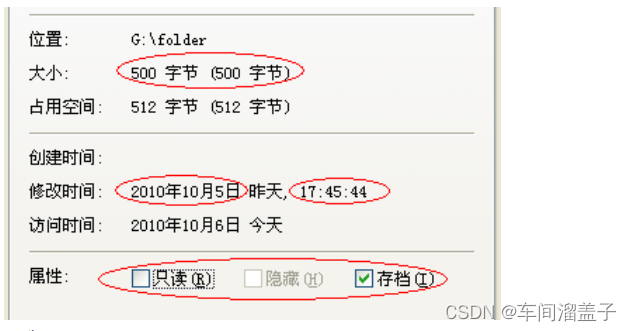
13、改变改变文件属性(f_chmod)
FRESULT f_chmod (
const TCHAR* FileName, /* Pointer to the file or directory */
BYTE Attribute, /* Attribute flags */
BYTE AttributeMask /* Attribute masks */
);
函数说明:
-
此函数可以修改文件或文件夹的属性
-
可修改的属性只能是以下一种或几种的组合,对其它属性无效
| Attribute | Description |
|–|–|
|AM_RDO |Read only|
|AM_ARC|Archive |
| AM_SYS | System |
| AM_HID| Hidden | -
参数说明:
a) *Filename:指向文件或文件夹的名称的指针
b) Attribute:要置位的属性
c) AttributeMask:需要改变的属性(包括要置位的和要清除的属性) -
使用方法:
a) Attribute 须为 AttributeMask 的子集
b) 函数对 AttributeMask 中的属性集合进行处理,若属性包含在 Attribute
中,则置位,否则清除
例程:
1.对文件 newname.txt,置位 ARC 和 SYS 属性,取消 HID 和 REO 属性
res = f_chmod("folder/newname.txt", AM_ARC | AM_SYS, AM_ARC | AM_RDO | AM_HID |
AM_SYS);
if( res )
Debug("err :%d\r\n", res);
else
{
res = f_stat("folder/newname.txt", &finfo);
Debug("%d\r\n",finfo.fattrib);
}
2.对文件夹 new,置位 SYS 和 ARC 属性,取消 HID 和 RDO 属性
res = f_chmod("new", AM_SYS | AM_ARC, AM_ARC | AM_RDO | AM_HID | AM_SYS);
if( res )
Debug("err :%d\r\n", res);
else
{
res = f_stat("new", &finfo);
Debug("%d\r\n",finfo.fattrib);
}
14、改变文件时间戳(f_utime )
FRESULT f_utime (
const TCHAR* FileName, /* Pointer to the file or directory path */
const FILINFO* TimeDate /* Time and data to be set */
);
函数说明:
- 此函数可以更改文件的最近修改时间
-
参数说明:
a) Filename :指向文件的指针
b) Timedate :指向文件信息结构体的指针 -
使用方法:
作者在官网中公布了另外一个函数 set_timestamp, 在这个函数里,可以我们可以写入常
规的日期时间,然后此函数按日期存储格式(见前文)将数据整合后调用 f_utime.
例:
FRESULT set_timestamp ( char *obj, /* Pointer to the file name */
int year, int month, int mday, int hour, int min, int sec
)//
{
FILINFO fno;
fno.fdate = (WORD)(((year - 1980) * 512U) | month * 32U | mday);
fno.ftime = (WORD)(hour * 2048U | min * 32U | sec / 2U);
return f_utime(obj, &fno);
}
res = set_timestamp("123.txt",2001,06,05,02,03,34);//修改 123.txt 时间
Debug("%d\r\n",res);
‘
执行函数后,串口返回 0
在 PC 上右键属性可以看到结果如下:

15、获取文件大小(f_size )
使用f_size函数需要先执行f_open,因为f_size参数是FIL结构体数据,f_open才能获取到数据。
FSIZE_t f_size (
FIL* fp /* [IN] File object */
);
举例:
uint8_t readFileFromSdDisk(char *rdFileName,char * s)
{
uint16_t len;
FRESULT ffres = FR_DISK_ERR;
ffres = f_open(&file,rdFileName , FA_READ);
if(FR_OK != ffres)
{
return FR_DISK_ERR;//关闭失败。。
}
len = f_size(&file);
ffres = f_read(&file,s,len,(void *)&fnum);
ffres = f_close(&file);
if(FR_OK != ffres)
{
return FR_DISK_ERR;//关闭失败。。
}
f_stat(rdFileName,&fileinfo);
return FR_OK;
}
//荧光值数据写入测试
uint8_t WriteFileToSdDisk(char *wrFileName,char * s,uint16_t len,uint8_t writeTpye)
{
FRESULT ffres = FR_DISK_ERR;
if(writeTpye==0)
{
ffres = f_open(&file,wrFileName , FA_CREATE_ALWAYS|FA_WRITE);//创建并覆盖
}
if(writeTpye==1)
ffres = f_open(&file,wrFileName , FA_OPEN_APPEND|FA_WRITE);//追加
if(FR_OK != ffres)
{
return FR_DISK_ERR;//关闭失败。。
}
// if (f_size(&sdFil) <offset)
// return FR_DISK_ERR;
//f_lseek(&sdFil,f_size(&sdFil)-sizeof(capvalue));
ffres = f_write(&file, s, len, (void *)&fnum);
ffres = f_close(&file);
if(FR_OK != ffres)
{
return FR_DISK_ERR;//关闭失败。。
}
f_stat(wrFileName,&fileinfo);
return FR_OK;
}
先写到这,后面的函数,用到时再研究:
• f_forward – Forward file data to the stream directly
• f_chdir – Change current directory
• f_chdrive – Change current drive
• f_getcwd – Retrieve the current directory
• f_gets – Read a string
• f_putc – Write a character
• f_puts – Write a string
• f_printf – Write a formatted string
